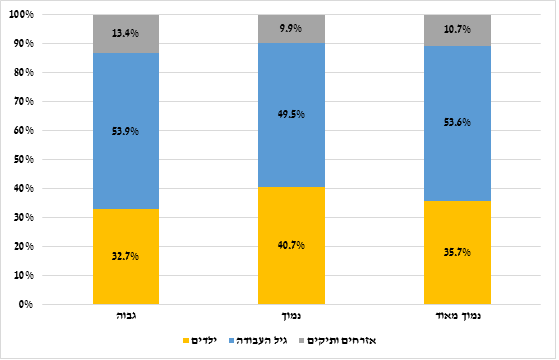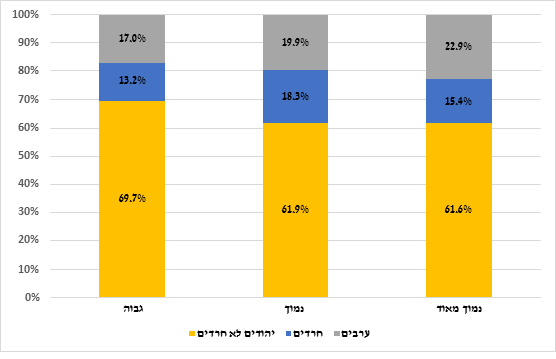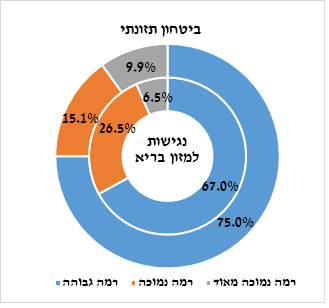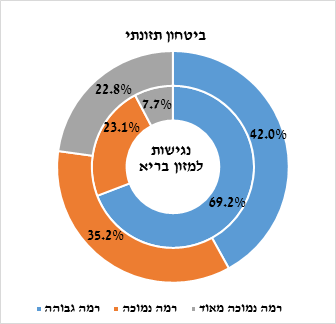More than a quarter of households in Israel live in food insecurity, which is about 2.8 million people, of which over a million are children.
Despite the slight improvement from 2023, the gaps remain deep and their consequences on the economy may lead to harming productivity, increasing public health spending and burdening the welfare budget.
The National Insurance presents the 2024 Food Security Report, which contains worrying data. The report was conducted by the National Insurance's Research and Planning Administration and reveals a wide-ranging phenomenon that directly affects the Israeli economy.
Key findings:
- According to professionals at the National Insurance Institute, each percentage point decrease in food insecurity could save the economy tens of millions of shekels per year, through reduced public health costs and improved labor productivity. 27.1% of households in Israel (approximately 968,000 households), including 2.8 million people (approximately 1 million children), live in food insecurity due to economic reasons. This is an improvement compared to 2023 (30.8%), but it is still a very high rate compared to OECD countries.
- 26.5% of households (about 963,000) reported inaccessibility to healthy food, inability to afford food that is not harmful to health.
- Food insecurity is particularly common among unique populations: 58% of Arab society, 25% of Haredi Jews community and in the periphery – Jerusalem 37% and the North 36.7%.
- Improvement compared to 2023: Households living in food insecurity decreased from 30.8% in 2023 to 27.2% in 2024; The rate of persons living in food insecurity decreased from 32.6% in 2023 to 28.1% in 2024; The rate of children living in households suffering from food insecurity is particularly high and stands at 31.7%, despite a decrease compared to 2023, when the rate was 36.0%. Among the elderly, 22.8% live in food insecurity. Here too, there was an improvement compared to 2023, when the rate was 25.2%. The National Insurance's Research Administration believes that the improvement during 2024 was created following the war in which hundreds of thousands of citizens from the north and south were evacuated to hotels and guesthouses - there being provided with regular hot meals.
- Gaps not only in income inequality but also gaps in employment opportunities and institutional support.
The report indicates a direct link between income level and food security: Among the bottom quintile, almost half of households (47.6%) lived in food insecurity, compared to only 9.5% in the top quintile. - Macroeconomic implications: Food insecurity harms labor productivity and the ability to integrate into the labor market of workers who suffer from food insecurity. In addition, we learn about an increase in healthcare system expenses as a result of chronic diseases, obesity, and malnutrition among children and adults. Deepening dependence on welfare benefits and burdening the state budget to the tune of hundreds of millions of shekels per year. This is damaging the human capital of our younger generation, with future implications for the economy's growth potential.
According to professionals at the National Insurance, every single percentage point decrease in food insecurity could save the economy tens of millions of shekels a year, through reduced health costs and improved labor productivity.
The National Insurance calls for the formulation of a national plan to reduce food insecurity, which includes:
- Increasing direct food aid budgets (such as food stamps) while supervising and monitoring food quality
- Expanding nutrition programs in the education system in disadvantaged areas
- Updating subsistence allowances and social insurance according to the increase in the cost of living
- And implementing multi-year measurable goals to reduce social gaps
Nitsa (Kaliner) Kasir, Deputy Director of Research and Planning at the National Insurance: "Food insecurity is not only a social problem but also an economic issue that requires systemic intervention. Families that cannot afford healthy food are facing increased risk of morbidity, absenteeism from work and low educational achievements. A long-term policy in this area will contribute not only to social well-being but also to the sustainable growth of the entire economy."
Additional data:
During the period under review, 27.1% of households were food insecure due to economic reasons, according to the following distribution: 17.2% with low food security and 9.9% with very low food security (Table 5). The proportion of persons living in food insecurity was 28.1%. The proportion of children in food insecure households was higher – 31.7%.
Food Security Levels (Absolute Numbers and Percentages), 2024
| Households
|
| Individuals
| | Adult individuals*
|
| Children
|
| | Total (thousands)
| Rate (%) |
Total
(thousands) | Rate (%) |
Total
(thousands) | Rate (%) |
Total
(thousands) | Rate (%) |
Food Security
(High Food Security) | 2,602 | 72.9 | 7,117 | 71.9 | 4,904 | 73.8 | 2,225 | 68.3 |
| Low Food Security | 615 | 17.2 | 1,808 | 18.3 | 1,111 | 16.7 | 709 | 21.8 |
| Very Low Food Security | 354 | 9.9 | 976 | 9.9 | 628 | 9.5 | 325 | 10.0 |
| Food insecurity (low and very low food security) | 968 | 27.1 | 2,784 | 28.1 | 1,739 | 26.2 | 1,034 | 31.7 |
* Aged 21 and over.
Food security of households, adults and children, by population groups:
Jews – total, non-Haredi Jews and Haredi Jews – and Arabs. Among non-Haredi Jews, 19.1% of households lived in food insecurity, with 6.4% in very low food security. The proportion of Haredi households living in food insecurity was higher at 25.0%, with 9.9% in very low food security. In Arab society, the proportion of households living in food insecurity was particularly high at 58.0%, compared to 20.2% in Jewish society. Of those living in food insecurity in Arab society, 35.2% lived in low food security and 22.8% in very low food security. The majority of households living in food security are non-Haredi Jews – 74.5%. In contrast, Arabs make up about 38% of households living in low food security and about 42% of households living in very low food security (Figure 1), rates that are much higher than their share of all households in Israel.
Population groups by level of food security, households (percentages), 2024

By age, the state of food security among seniors was better compared to other groups, but even among them the rate of those living in food insecurity was high (22.8%). The rate of children in households living in food insecurity was particularly high – 31.7%.
Age groups (aged 65 and over, primary working age*, children) by level of food security (percentage), 2024

* Ages 21–65.
Households suffering from lack of access to healthy food (for economic reasons) are particularly high in the Haredi Jews and Arab societies, standing at 33.0% and 30.8% respectively. In 2024, there was an improvement in access to healthy food across all populations, reflected in an increase in the proportion of households with access to healthy food, and a decrease in the proportion of households with low or very low access to healthy food.
Zvika Cohen, Deputy Director General of the National Insurance Institute: "Israeli society must strive and act more vigorously to substantially and significantly reduce food insecurity among children and the elderly in the country. A functioning society cannot afford inequality gaps expressed in a higher need for access to healthy food, and we must do everything to improve the current situation. This National Insurance report is a tool that reflects the situation to policymakers in such a way that they can act in accordance with the means at their disposal for the benefit of the food security of the residents of Israel."
Population groups by level of accessibility to healthy food, households (percentages), 2024

Among the Jewish population, both Haredi and non-Haredi Jews, the number of households that reported inaccessibility to healthy food (inability to afford healthy food) was higher than the number of those reporting food insecurity. The opposite is observed in the Arab population: the number of households unable to afford food that is not harmful to health (31.3%) was significantly lower than the proportion of households living in food insecurity (57.9%).
a. Non-Orthodox Jews

| b. Orthodox Jews

|
c. Jews (total)
.png)
| d. Arabs

|